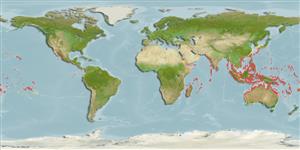Common names from other countries
Classification / Names / Names
ماع يماسا | فدارتم | Catalog of Fishes (gen., sp.) | ITIS | CoL | WoRMS
Environment: milieu / climate zone / depth range / distribution range
يسانش موب
. Tropical
Indo-Pacific: East Africa to eastern Polynesia; absent from Australia, apart from some oceanic coral reefs off northwest Australia.
Length at first maturity / Size / Weight / نس
Maturity: Lm ? range ? - ? cm Max length : 6.0 cm ShH يسنج صاوخ نودب / رن سنج; (Ref. 349); common length : 4.5 cm SHL يسنج صاوخ نودب / رن سنج; (Ref. 349)
Locally collected for food or for its shell (Ref. 349). Inhabits rather rough waters, under slabs and stones or in hollow corals near the wave swept edge. Active at night on algal crests and rock platforms. Also found in shallow subtidal zones (Ref. 349).
Life cycle and mating behavior
غولب | لثم دیلوت | یزیر مخت | اه مخت | Fecundity | )ورال ( دازوت
Members of the order Neotaenioglossa are mostly gonochoric and broadcast spawners. Life cycle: Embryos develop into planktonic trocophore larvae and later into juvenile veligers before becoming fully grown adults.
یلصا ذخآم
عجارم | هدننك گنهامه | ناراكمه
Poutiers, J.M. 1998. (Ref. 349)
NCUI زمرق تسرهف رد تيعضو (Ref. 130435)
ستياس رظن زا تيعضو (Ref. 108899)
Not Evaluated
Not Evaluated
اه ناسنا یارب رطخ
Harmless
یناسنا هدافتسا
| FishSource |
اهرازبا
يتنرتنيا عبانم
Estimates based on models
Preferred temperature
(Ref.
115969): 25.4 - 29.5, mean 28.3 (based on 476 cells).
یريذپ بيسآ
Low vulnerability (10 of 100).
تميق هقبط
Unknown.
